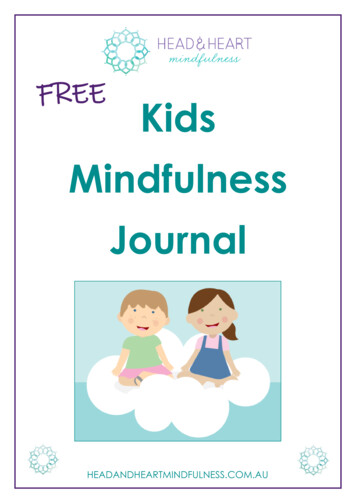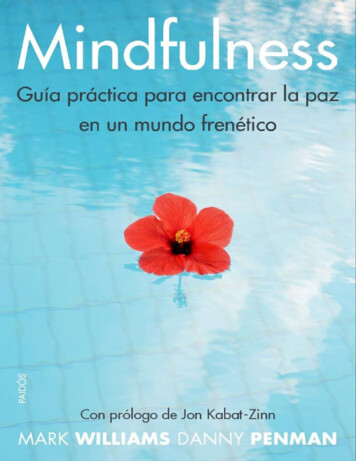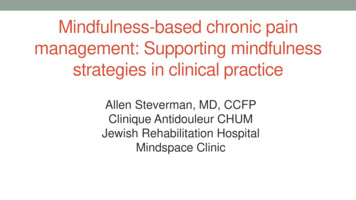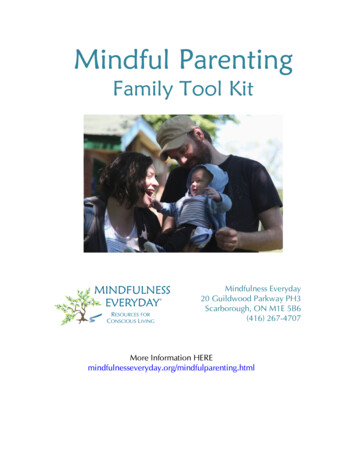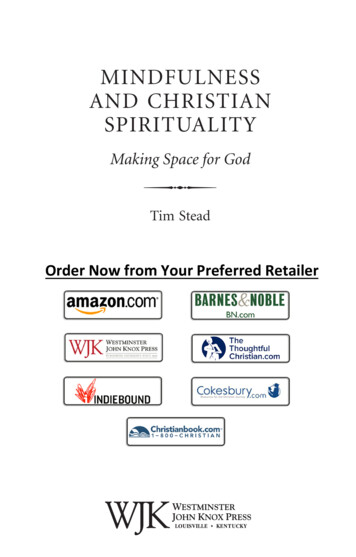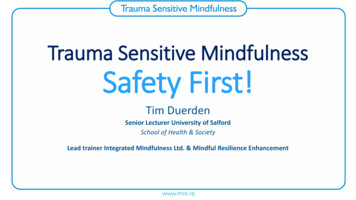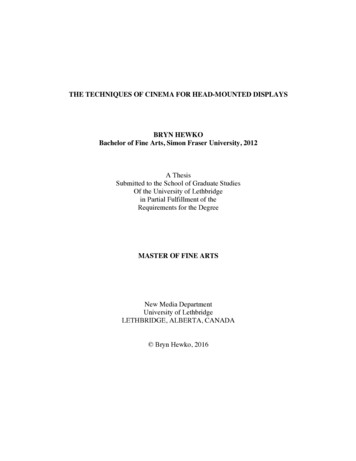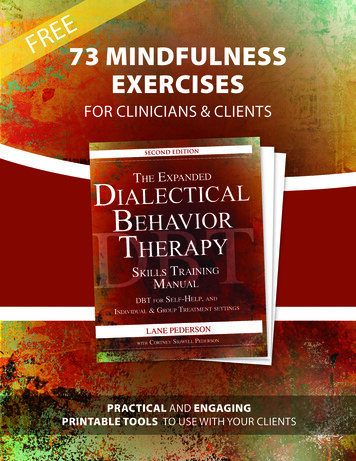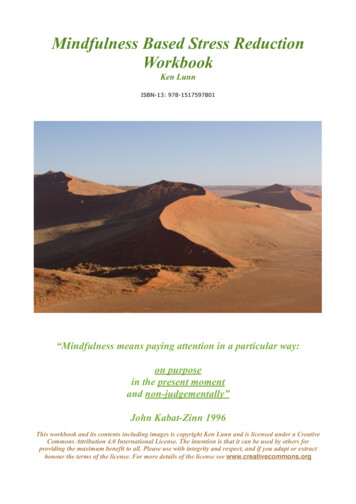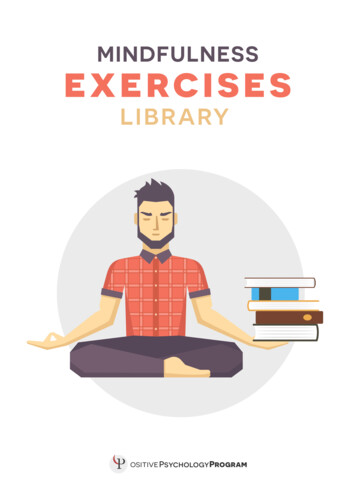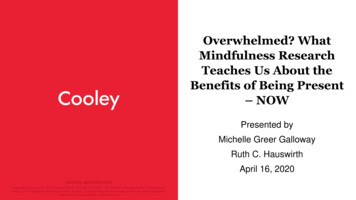
Transcription
Overwhelmed? WhatMindfulness ResearchTeaches Us About theBenefits of Being Present– NOWPresented byMichelle Greer GallowayRuth C. HauswirthApril 16, 2020attorney advertisementCopyright Cooley LLP, 3175 Hanover Street, Palo Alto, CA 94304. The content of this packet is an introduction toCooley LLP’s capabilities and is not intended, by itself, to provide legal advice or create an attorney-client relationship.Prior results do not guarantee future outcome.
Your Presenters Michelle Greer Galloway, Of Counsel at Cooley LLP and AdjunctProfessor at Santa Clara and Stanford Law Schools Contact Michelle at 650-843-5161or mgalloway@cooley.com Ruth C. Hauswirth, Special Counsel & Director of Litigation & EDiscovery Services at Cooley LLP Contact Ruth at 858-550 6108 or rhauswirth@cooley.com2
Overview Duty of Competence – Time, Attention and Energy to Do the Work Your Brain Stressed -- What Happens to Mind and Body Mindfulness – What It Is? Mindfulness Practice Mindfulness – How and Why It Works3
Who Has Felt This Way?4
Auto Pilot5
Duty of Competence and OtherEthical Duties
CA Rule 1.1 Competence (a) A lawyer shall not intentionally, recklessly, with grossnegligence, or repeatedly fail to perform legal services withcompetence. (b) For purposes of this rule, “competence” in anylegal service shall mean to apply the (i) learning and skill, (ii)mental, emotional, and physical ability reasonably* necessary forthe performance of such service.7
Stress and Competence What happens to our competence as attorneys under extremestress? To decision making? To having difficult discussions with clients, colleagues, opposing counsel,courts? To professionalism?8
Emotional Intelligence9
Model Rule 1.3 Diligence “Client-Lawyer Relationship A lawyer shall act with reasonable diligence and promptness inrepresenting a client.”10
Model Rule 1.3 Comments -- Procrastination “3] Perhaps no professional shortcoming is more widely resented thanprocrastination. A client’s interests often can be adversely affected by thepassage of time or the change of conditions; in extreme instances, as when alawyer overlooks a statute of limitations, the client’s legal position may bedestroyed. Even when the client’s interests are not affected in substance,however, unreasonable delay can cause a client needless anxiety andundermine confidence in the lawyer’s trustworthiness. A lawyer’s duty to actwith reasonable promptness, however, does not preclude the lawyer fromagreeing to a reasonable request for a postponement that will not prejudicethe lawyer’s client.”11
Increasing Emphasis On Mindfulness and LawPractice Charity Scott, Mindfulness in Law: A Path to Well-Being and Balance forLawyers and Law Students, 60 Ariz. L. Rev. 635 (2018) Peter H. Huang, Can Practicing Mindfulness Improve Lawyer DecisionMaking, Ethics and Leadership, 55 Hous. L. Rev. 63 (2017) Katerina P. Lewinbuk, Christy Gilbert, Law Student Heal Thyself: TeachingMindfulness as a Legal Skill, 41 J. Legal Prof. 37 (2016) Katerina June Lee, A Call for Law Schools to Link the Curricular Trends ofLegal Tech and Mindfulness, 48 U. Tol. L. Rev. 55 (2016)12
“Goodies”: Some Benefits of MindfulnessCompassion Practices Physical Health Reduced stress Pain management Improved immune function Reduced inflammation Cardiovascular benefits (lowered bloodpressure, lowered heart rate) Improved memory Aging process (telomere studies &biological age) Emotional Health/Well-Being Helps regulate emotions (helps withanxiety and depression) Strengthens resilience Increased awareness Better attention, focus, clear thinking andperception More feelings of calm (less reactivity) Feeling more connected (to self, others,nature) Increased happiness and sense of wellbeing13
Preparing For Competent Practice14
This is Your Brain – Stressed!
Zebras16
17
18
Within 1 Minute19
Threat epression20
Stress Hormones Adrenaline -- increases heart rate, elevates your blood pressure Cortisol -- increases sugars (glucose) in the bloodstream; curbsthe nonessential systems Norepinephrine -- more alert/awake; shifts blood to essentialorgans21
Mindfulness – When Stress is “Out of Control” Prefrontal cortex designed to manage anxiety of anticipation If you are already stressed, the prefrontal cortex does not functionnormally to manage anxiety of negative anticipation/expectation A strategy that bypasses Prefrontal cortex – mindfulness – don’tcontrol thoughts but let them go22
Attorney Substance Abuse ABA and Hazelden Betty Ford Foundation study in 2016 “The study reports that 21 percent of licensed, employed attorneys qualifyas problem drinkers, 28 percent struggle with some level of depressionand 19 percent demonstrate symptoms of anxiety. The study found thatyounger attorneys in the first 10 years of practice exhibit the highestincidence of these problems.” dy-attorney-substance-use23
Loneliness In a recent study on loneliness: “In a breakdown of loneliness and social support rates by profession, legalpractice was the loneliest kind of work, followed by engineering andscience. This is perhaps not surprising, given the known high prevalenceof depression among lawyers.” Shawn Achor, Gabriella Rosen Kellerman, Andrew Reece, and Alexi Robichaux,America’s Loneliest Workers, Harvard Business Review (Mar. 19, 2018) “Research shows that loneliness has the same effect as 15 cigarettes aday in terms of health care outcomes and health care costs.” Id.24
Current Proposals Re Attorney Well-Being ABA NATIONAL TASK FORCE ON LAWYER WELL-BEING:Creating a Movement To Improve Well-Being in the LegalProfession (2017)25
ABA National Task Force The Path To Lawyer Well-being: Practical Recommendations For PositiveChange, The Report Of The National Task Force On Lawyer Well-being26
Stress and Shelter In Place Is stress during shelter in place different? If so, how can we mitigate impacts?27
Mindfulness Defined
Jon Kabat-Zinn“Mindfulness means payingattention in a particularway: on purpose, in thepresent moment, andnonjudgmentally.”29
Dan Harris “[T]he ability to recognize what is happening in your mind rightnow – anger, jealousy, sadness, the pain of a stubbed toe,whatever – without getting carried away by it.” Dan Harris, 10% Happier30
Mindfulness Meditation Mindfulness meditation: one type of meditation, likebasketball is a type of sport Going to the “Mind Gym” to build “awarenessmuscle” Formal practice – focus, concentration training Informal or integrative practice – bringing a quality ofattention to any activity Point: cultivating attention and awareness skills(recognizing, stabilizing, regulating) that lead tomore resiliency and well-being31
Thoughtless? Mindfulness meditation or practice is NOT “thinking about nothing” Our minds are thinking and meaning making machines – can’tturn them off Instead Choosing to pay attention/focus Observing ourselves Noticing our patterns of thoughts32
Why? We don’t meditate to become better meditators.We meditate so we can bring mindfulness out intothe real world, and thrive in our interactions withothers. Diana Winston, Director of Mindfulness Education atUCLA’s Mindful Awareness Research Center, co-authorof Fully Present: The Science, Art and Practice ofMindfulness A clearer lens Getting to know our own minds and patterns Flourishing (not just survival mode) for ourselvesand all Wiser, more skillful responses perfect33
Neuroplasticity “Neurons that fire together, wire together.” HansonScience Negativity bias: “Our brains are like Velcro for the negative andTeflon for the good.” Hanson Hope! Our brains continue to change and we can create newneural pathways What we do and practice gets stronger34
Awareness
Mindfulness Homo sapiens sapiens The person who thinks and knows what he or she thinks I.e. thinking or awareness about our thoughtsThinking a thoughtObserving the thought36
Automatic or Aware – Listening Automatic Aware Go straight to problem solving Listen for connection Give a solution Solving together37
Mindfulness Allows us to respond (intentionally) rather than react (instinctually) Secular application in work-place Cognitive Aware of context and perspectives Curiosity; flexibility in response to changing conditions38
In The Present
MindLESSness Auto-pilot Average 60,000 thoughts a day (many recycled, habitual) “Monkey Mind” / Scattered mind Past or future v. attention on immediate experience Rumination, fretting, worry, worst-case-scenarios, negativity 2010 Harvard Study: Mind Wandering Found we spent 47% of our time mind wandering “The ability to think about what is not happening is acognitive achievement that comes at an emotional cost.” AWandering Mind Is an Unhappy Mind, Matthew A.Killingsworth, Daniel T. Gilbert Science 12 Nov 2010: Vol.330, Issue 6006, pp. 93240
Facts?41
Human “Being” Being Awareness Present moment Without judgment42
Without Judgment
What We Practice Grows Stronger Attitude – crucial element“Non-judgmentally”“With open curiosity and kindness”“Secret sauce” (Shauna Shapiro)Research shows this matters and isnot just “nice” Neuroplasticity – what you practicegrows stronger
Stress Response & Our Care System Mammalian care system Later developed part of our brain & also survival based Oxytocin Nurturing, safety, caring, connection and belonging Engaging Pre-Frontal Cortex (impulse control, executivefunctioning, problem-solving) Opens perspective, creativity and ability to see possibilities,different angles, wisdom, clarity45
Mindfulness & Compassion Compassion A desire to alleviate suffering of others and ourselves during timesof difficulty, stress and pain Friend and ally or foe? Growing body of research shows self-compassion is apowerful capacity to help people deal more effectively withadversities and difficult emotions Key skill (not just a fluffy, nice thought) See Kristin Neff, leading researcher, University of Texas. Austin https://self-compassion.org/ (test for self-compassion)46
Mindfulness & Compassion Mindful Self-Compassion Mindfulness Common humanity Self-kindness
Acceptance48
Mindfulness and Implicit Bias Abstract Research has shown that mindfulness can positively affect peoples’ lives in a number ofways, including relying less on previously established associations. We focused on theimpact of mindfulness on implicit age and racial bias as measured by implicit associationtests (IATs). Participants listened to either a mindfulness or a control audio and thencompleted the race and age IATs. Mindfulness meditation caused an increase in statemindfulness and a decrease in implicit race and age bias. Analyses using the Quad Modelshowed that this reduction was due to weaker automatically activated associations on theIATs. See Lueke and Gibson, “Mindfulness Meditation Reduces Implicit Age and Race Bias: The Role ofReduced Automaticity of Responding,” Social Psychological and Personality Science (Nov. 24,2014)49
Mindfulness & The Brain
RUTH51
Mindfulness Meditation –Practice Barriers “Can’t quiet my mind or turn off mythoughts.” “Can’t relax” “No time” Perfectionism/judgment Attached to outcome/striving forresults/“to do” item
Learning New Skills Developing new skills To attend/focus attention To tolerate emotions To respond, not react To observe, not judge53
MBSR Mindfulness-Based Stress Reduction (MSRB) was developed in1970s by Professor Jon Kabat-Zinn 8 week workshop Includes mindfulness meditation, body scanning and simple yoga postures54
Mindfulness – Changing the Brain “The results suggest that participation in MBSR is associated withchanges in gray matter concentration in brain regions involvedin learning and memory processes, emotion regulation, selfreferential processing, and perspective taking.” Sara W. Lazar, et al., Mindfulness Practice Leads To Increases InRegional Brain Gray Matter Density, Psychiatry Research:Neuroimaging (Jan. 30, 2011)55
Therapeutic Approaches with MindfulnessComponent Mindfulness Based Cognitive Therapy Dialectic Behavior Therapy56
Starting A Mindfulness/MeditationPractice
Books58
Mindfulness and Lawyers www.mindfulnessforlawyers.com/ https://jeenacho.com/mindfulness-for-lawyers/ https://warriorone.com/ themindfullawyer.com/ https://mindfulnessinlawsociety.com/59
Getting Started60
Best Meditation Practice? “The one you actually do.” Richard Davidson, a leading neuroscience researcher, Universityof Wisconsin on meditation and the brain – On Being with KristaTippett – Podcast; see also Altered Traits: Science Reveals HowMeditation Changes Your Mind, Brain and Body, Davidson andDaniel Goldman Not formulaic “Don’t be a bliss ninny” Practice both formal and integrated mindfulness Try bringing an attitude of kindness and openness (v.judgmental) to your meditation practice
Skeptics Start62
Purpose, Power63
Apps64
Conclusions
Some Days . . .66
Conclusion These materials are intended as an introduction to the subject mattercovered in the presentation. The presentation and the materials containedherein do not attempt to provide legal advice for any particular situation.Each particular situation must be analyzed individually in light of all of thesurrounding facts and circumstances. Because of the complexity of the legalissues that will always arise in connection with the subject matter hereof, it iscritical that counsel be involved. These materials are provided for educationaland discussion purposes only and are not to be copied, used or distributedoutside of this seminar without the express written consent of Michelle GreerGalloway or Cooley LLP. Copyright Michelle Greer Galloway 2020.22316401267
Increasing Emphasis On Mindfulness and Law Practice Charity Scott, Mindfulness in Law: A Path to Well-Being and Balance for Lawyers and Law Students, 60 Ariz. L. Rev. 635 (2018) Peter H. Huang, Can Practicing Mindfulness Improve Lawyer Decision- Making, Ethics and Leadership, 55 Hous. L. Rev. 63 (2017) Katerina P. Lewinbuk, Christy Gilbert, Law Student Heal Thyself: Teaching
